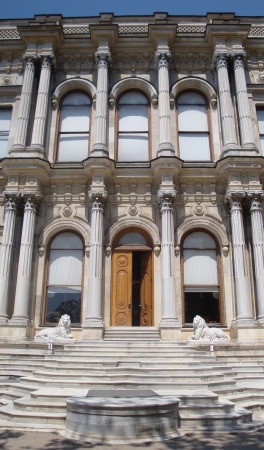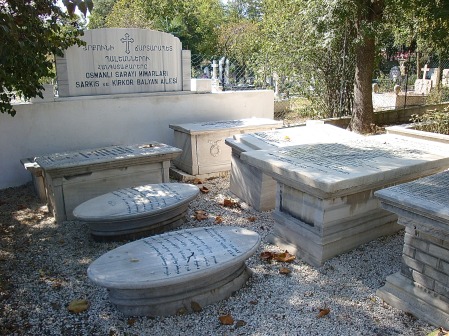Almost every visitor to İstanbul gets to hear about the great Ottoman architect Sinan. Far fewer hear about the extraordinary Balyans, even though this talented family of Armenian architects left their fingerprints all over the 19th-century city, reversing the old Ottoman style in which decoration was focused on the inside of outwardly austere buildings in favour of a more Western style in which the ornamentation was lavished on the exterior.
The trouble is that the style of architecture in vogue in their day – a florid local form of baroque – has since fallen from favour. Today there are probably more people who admire the cool, classic lines of a Sinan mosque than appreciate the extravagant stone swags and garlands adorning a Balyan palace. Nor does it help that the buildings created by the Balyans tended to be stuffed full of the sort of over-the-top furnishings – outsize chandeliers, giant porcelain vases, endless inlaid furniture – that even lovers of maximalism find hard to stomach.
But the fact remains that the city would not be what it is without the Balyans.
The founder of the extraodinary dynasty was Meremmetçi Bali Kalfa (? – 1725) who came from near Karaman in Central Anatolia. Having somehow heard about the success of a fellow Armenian architect at the court of Sultan Mehmed IV, he made his way to Constantinople and succeeded in securing a post for himself which then passed to his son Magar. Magar fell foul of Sultan Mahmud I and was exiled to Bayburt where he taught his sons, Krikor and Senekerim, architecture.
It was with Krikor Amira Balyan (1764-1831) that the great days of the family firm began in earnest. Sadly, many of the buildings he bequeathed to the city have since been lost although the Nusretiye (Victory) Cami in Tophane is still standing as are the elegant Valide and Topuzlu dams (reservoirs) in the Belgrade Forest and the Feshane alongside the Golden Horn at Eyüp. Krikor was also responsible for three wings of the giant Selimiye Barracks – visible as you sail to Kadıköy – after it had to be expanded to house Sultan Mahmud II’s new professional army.
Less well known, Krikor’s younger brother, Senekerim (1763-1833), nevertheless left the city one of its most conspicuous landmarks, the Serasker Fire Tower that stands in the grounds of İstanbul University in Beyazıt. Ironically, it was a replacement for the first tower, built of wood by brother Krikor, that had burnt down.
But it was Magar’s youngest son, Garabet Amira Balyan (1800-66), who really made the city his own. It was he who was responsible, with his son, Nikoğos, for the Dolmabahçe Palace, built for Sultan Abdülmecid and such a mammoth undertaking that it took from 1843 to 1856 to complete. The palace contains a daunting 258 rooms although the public only get to see a tiny fraction of them, most attention focusing on on the stupendous 38m-high Ceremonial Hall with its concealed dome where the later sultans presided over festivities to celebrate the different bayrams (holidays), and on the considerably smaller room in which Mustafa Kemal Atatürk breathed his last on 10 November 1938. It shows what a grip the Balyans had on court architecture at the time that the wooden Beşiktaş Palace that had stood on the site before Dolmabahçe had itself been a work of Garabet’s older brother, Krikor.
 Beylerbeyi PalaceMany people find a visit to the Dolmabahçe overwhelming. On the other side of the Bosphorus, however, Beylerbeyi Palace, built in 1865 towards the end of his life by Garabet in collaboration with his even more prolific son, Sarkis, is more manageable, its most beautiful feature being a lovely internal pool presided over by a marble fountain adorned with dolphins that was intended to cool and soothe palace occupants during the extreme heat of high summer.
Beylerbeyi PalaceMany people find a visit to the Dolmabahçe overwhelming. On the other side of the Bosphorus, however, Beylerbeyi Palace, built in 1865 towards the end of his life by Garabet in collaboration with his even more prolific son, Sarkis, is more manageable, its most beautiful feature being a lovely internal pool presided over by a marble fountain adorned with dolphins that was intended to cool and soothe palace occupants during the extreme heat of high summer.
Garabet’s other masterwork is the exquisite mosque that juts out from the waterside at Ortaköy, an unmissable landmark as people cruise up and down the Bosphorus and one that has a virtual twin in the equally lovely, light-filled Dolmabahçe Cami, designed by Nikoğos. People strolling along Divan Yolu in Sultanahmet will also pass the mausoleum housing the remains of Sultans Mahmud II, Abdülaziz and Abdülhamid II, another work of Garabet dating from 1840.
Less obvious are the diminutive Nusretiye clock tower that he built in 1848, the first such tower in the city; and the enormous Surp Asdvadzadzin Church in Beşiktaş that you will pass if you walk downhill to the ferries from Abbasağa Park. Garabet was also responsible for the attractive Gümüşsuyu Hastanesi (Military Hospital) on Gümüşsuyu Caddesi, the road running down to Dolmabahçe from Taksim Square. He even designed the Abud Efendi Yalısı at Kandilli, used as the setting for a smash-hit TV series called Gümüş (Silver).
Nikoğos Balyan (1826-58) had a tragically short life during which he nevertheless designed a couple of the city’s smaller treasures: the Küçüksu Kasrı at Kandilli and the Ihlamur Kasrı in Beşiktaş. Intended as pavilions in which a travelling sultan could rest rather than as permanent homes, both these buildings showcase the elaborate baroque features of Balyan architecture without leaving the visitors drowning in excessive detail. It was Nikoğos, too, who was responsible for the pretty Küçük Mecidiye Cami, built in 1848 across the road from the Çırağan Palace, itself designed by his brother, Sarkis. He was also responsible for the Adile Sultan Palace, built in Kandilli in 1853 and now housing the excellent Kandilli Borsa restaurant.
The work of Sarkis Balyan (1835-99) will be familiar to residents of two of the city’s top hotels: the Çırağan Palace Kempinski which was rebuilt in 1990 as a copy of the original which had burnt down in 1910; and the W Hotel at Akaretler which was created out of the terraced houses built to accommodate workers at the Dolmabahçe Palace in the 1870s. The beautifully restored Valide Sultan Cami in Aksaray, built in 1871, is also sometimes attributed to Sarkis and his brother, Agop. In 1889 Sarkis expanded the Şale (Chalet) guesthouse in the grounds of the Yıldız Park in preparation for the state visit of Kaiser Wilhelm II. He also added the delightful Malta Köşkü to the grounds, equipping it in 1870 with an interior pool rather like the one inside the Beylerbeyi Palace but with marble swans replacing the dolphins. The Sarı Köşkü that he installed in Emirgan Woods in the 1870s was designed to imitate a Swiss chalet. It now houses a pleasant small cafe.
Although Agop Balyan (1838-75) worked on several projects with his brother, it was really with Sarkis that the great dynasty of architects came to an end. It had served no fewer that six sultans over five generations, bequeathing an unprecedented quantity and variety of buildings to İstanbul.
The Balyans are buried in a family plot in the Armenian Cemetery on Nuhkuyusu Caddesi in Bağlarbaşı in Üsküdar.
 The Balyan family burial plot on Bağlarbaşı
The Balyan family burial plot on Bağlarbaşı
